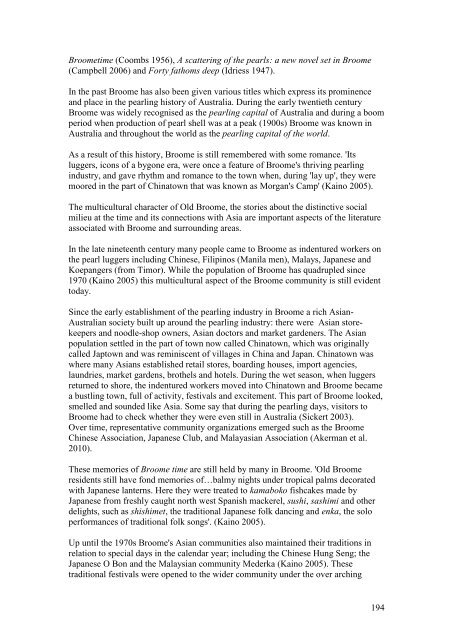WEST KIMBERLEY PLACE REPORT - Department of Sustainability ...
WEST KIMBERLEY PLACE REPORT - Department of Sustainability ...
WEST KIMBERLEY PLACE REPORT - Department of Sustainability ...
Create successful ePaper yourself
Turn your PDF publications into a flip-book with our unique Google optimized e-Paper software.
Broometime (Coombs 1956), A scattering <strong>of</strong> the pearls: a new novel set in Broome<br />
(Campbell 2006) and Forty fathoms deep (Idriess 1947).<br />
In the past Broome has also been given various titles which express its prominence<br />
and place in the pearling history <strong>of</strong> Australia. During the early twentieth century<br />
Broome was widely recognised as the pearling capital <strong>of</strong> Australia and during a boom<br />
period when production <strong>of</strong> pearl shell was at a peak (1900s) Broome was known in<br />
Australia and throughout the world as the pearling capital <strong>of</strong> the world.<br />
As a result <strong>of</strong> this history, Broome is still remembered with some romance. 'Its<br />
luggers, icons <strong>of</strong> a bygone era, were once a feature <strong>of</strong> Broome's thriving pearling<br />
industry, and gave rhythm and romance to the town when, during 'lay up', they were<br />
moored in the part <strong>of</strong> Chinatown that was known as Morgan's Camp' (Kaino 2005).<br />
The multicultural character <strong>of</strong> Old Broome, the stories about the distinctive social<br />
milieu at the time and its connections with Asia are important aspects <strong>of</strong> the literature<br />
associated with Broome and surrounding areas.<br />
In the late nineteenth century many people came to Broome as indentured workers on<br />
the pearl luggers including Chinese, Filipinos (Manila men), Malays, Japanese and<br />
Koepangers (from Timor). While the population <strong>of</strong> Broome has quadrupled since<br />
1970 (Kaino 2005) this multicultural aspect <strong>of</strong> the Broome community is still evident<br />
today.<br />
Since the early establishment <strong>of</strong> the pearling industry in Broome a rich Asian-<br />
Australian society built up around the pearling industry: there were Asian storekeepers<br />
and noodle-shop owners, Asian doctors and market gardeners. The Asian<br />
population settled in the part <strong>of</strong> town now called Chinatown, which was originally<br />
called Japtown and was reminiscent <strong>of</strong> villages in China and Japan. Chinatown was<br />
where many Asians established retail stores, boarding houses, import agencies,<br />
laundries, market gardens, brothels and hotels. During the wet season, when luggers<br />
returned to shore, the indentured workers moved into Chinatown and Broome became<br />
a bustling town, full <strong>of</strong> activity, festivals and excitement. This part <strong>of</strong> Broome looked,<br />
smelled and sounded like Asia. Some say that during the pearling days, visitors to<br />
Broome had to check whether they were even still in Australia (Sickert 2003).<br />
Over time, representative community organizations emerged such as the Broome<br />
Chinese Association, Japanese Club, and Malayasian Association (Akerman et al.<br />
2010).<br />
These memories <strong>of</strong> Broome time are still held by many in Broome. 'Old Broome<br />
residents still have fond memories <strong>of</strong>…balmy nights under tropical palms decorated<br />
with Japanese lanterns. Here they were treated to kamaboko fishcakes made by<br />
Japanese from freshly caught north west Spanish mackerel, sushi, sashimi and other<br />
delights, such as shishimet, the traditional Japanese folk dancing and enka, the solo<br />
performances <strong>of</strong> traditional folk songs'. (Kaino 2005).<br />
Up until the 1970s Broome's Asian communities also maintained their traditions in<br />
relation to special days in the calendar year; including the Chinese Hung Seng; the<br />
Japanese O Bon and the Malaysian community Mederka (Kaino 2005). These<br />
traditional festivals were opened to the wider community under the over arching<br />
194
















